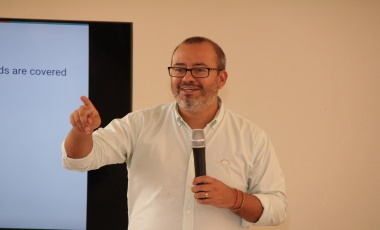
KINGSTOWN, St. Vincent, Nov 9, A United Nations agency is using St. Vincent and the Grenadines’ response to multiple hazards, some of them simultaneously, over the last two years as a case study for disaster risk reduction around the world.
In 2019, the island faced an outbreak of dengue, followed by the coronavirus (COVID-19) pandemic beginning the following year. Then, in April 2021, the La Soufriere volcano erupted, forcing over 20,000 people — one-fifth of the nation’s population — to flee their homes for emergency shelters or to live with relatives.
In July 2021, even as thousands of people were in emergency shelters and trying to repair homes damaged by the volcanic eruption, the country was also affected by Hurricane Elsa.
“So, all of these things, for us, are very interesting to understand better how we can provide recommendations, how we can support governments, how we can support communities in order to ensure that these early warning systems pass from this technical perspective to really to be embedded on the disaster risk management,” Jair Torres, senior consultant to the United Nations Office for Disaster Risk Reduction (UNDRR) office in Panama, told the Caribbean Media Corporation (CMC).
“These early warning systems are not the alarm but are the capacity of communities, individuals, and institutions to take action when the hazard is imminent when we really have something on which we really need to take action,” he said on the sidelines of a workshop in Bequia, on an understanding of risk and early warning systems perceptions of institutions and communities.
Torres said that since the Sendai Framework for Disaster Risk Reduction was adopted in 2015, discussion began about an all-hazards approach and systemic risk.
“So, about this linkage between different systems — natural systems, social systems, etc. — and how this produces risk among them,” Torres said, noting “also, about the underlying risk factors and the way, how the choice, the decisions that we take on our development pathways really create new risks.”
He said that this was something theoretical, and then COVID struck and helped to crystalize it, and it was very interesting to see how governance for systemic risk was happening.
“And the case of St. Vincent and the Grenadines was a very particular one,” he said, adding that with COVID-19 following the dengue outbreak, the country moved from epidemic to pandemic in the cluster of biological hazards.
Torres noted that this called for action from the health sector in collaboration with the National Emergency Management Organisation (NEMO) to manage the epidemic and pandemic at the same time.
“But at the same time, you also have to manage the hurricane season and the negative impacts of Hurricane Elsa and the flooding that you have in St. Vincent and the Grenadines.
“So, you see how two different clusters of hazards, one that is biological and another one that is meteorological, start interacting with each other because you have very good plans,” Torres said.
He said that in the case of the hurricane season, St. Vincent and the Grenadines have standard operating procedures that include opening emergency shelters when a cyclone reaches a particular threshold.
“… but how [do you] send people to shelter when you are in the middle of a pandemic? So, that creates a lot of issues and questions that really create the need in the country to be agile and to be responsive in terms of policy, in terms of procedures, in a very fast way, and understand the connections between different hazards,” Torres told CMC.
“And this is why we talk about the multi-hazard early warning systems. It’s not a system that covers all of the hazards. But it’s a system that really takes into consideration all the connections between the different systems, everyone in systems for biological hazards, methodological hazards. And then the volcano erupted, so, for geological hazards, how do you link with these interconnections?”
He said the response was well demonstrated in St. Vincent and the Grenadines,” where legislation was produced in a very agile and fast way and where the lessons learned are big.
“For instance, the need to have legislation that is flexible, to face the new surprises, the surprises that we are living today. So, this is why we are very much interested in the case of St. Vincent and the Grenadines.
“And this is what we are trying to get the most of the lessons from the country in order to bring it to the region but then to other regions in the world, for instance, like Asia and the Pacific, which are very much interested because they have the same kind of context.”
Torres said that the lessons learned from the case of St. Vincent and the Grenadines are going to be implemented in different ways.
“The first one has already been integrated into the midterm review of the implementation of the Sendai Framework that we were doing these years. So, these lessons are now lessons that we take about how to advance the agenda of multi-hazard early warning systems and how to advance the agenda of the governance approach that we want. That is one of the priorities of Sendai.”
He said the lessons would also inform the process of the Caribbean Disaster Emergency Management Agency (CDEMA) and the CARICOM comprehensive disaster management strategy, which CDEMA leads at the regional level.
“But similarly, they will inform the whole UN in the recommendations that have been in the midterm review but also in the recommendations that we will provide in terms of how to improve the governance of multi-hazard early warning systems.”






















































 and then
and then